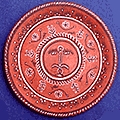The painted terracotta of Gujarat is unique for the dramatic impact made by the deep, rich terracotta base colour combined with the minimalistic pattern painted on it in stark black and white. Less than a handful of artisans practise this craft that is unique to Gujarat. The pots are shaped by the men on the wheel; other shapes, mainly toys are also hand-moulded by the men. The painting is done by the women of the family, while the pots rotate on an improvised pivot. Resembling embroidery, these lines and motifs create rich and intricately designed pottery.
Only a handful number of artists practice this age-old craft of hand painted terracotta in Kutch and Surendranagar. Wares are made using locally available clay on the wheel and the ornamentation is carried out by the womenfolk. Base coat is created using a dark terracotta colored slip of watered down geru, red clay and then patterns are created in black and white using bamboo stick brushes. Wares such as water pots called maatlo, money boxes called gallo and pots etc are created.

This craft is practised only by a few artisans from the Kutch and Surendranagar regions of Gujarat including Hasam Umar Kumbhar and his wife Amina Hasam Kumbhar who are both National Award winners and whose creations include pots, toys, diyas, mobiles, plates and bowls. This technique of decorating pots is not practised at any other location in India.
Three different colours of clay are used to create the final finished product: the red clay (geru) for the pots and the white and black clay used for painting on the red base. The clay is collected by the artisans from three different sites and prepared for use by grinding and sieving.The process followed appears very simple but requires extreme dexterity and skill. The style of painting is also unique. Out of the locally available clay, pots of various sizes and shapes are made on the wheel while the toys are moulded by hand. This task is always performed by the men. Once the articles are well dried, they are coated with watered down red clay (geru) to achieve the typical dark terracotta colour that forms the base for the painting, after which the
 products are dried once again in the sun. The painting on the pots and toys is done only by the women. A dramatic combination of black and white – also obtained clay – is used,. The clay is mixed with water to achieve the required consistency and the designs are painted on the pots with the help of a twig. These brushes of bamboo sticks are sharpened at one end and beaten to form a brush-like end. The article to be painted is rotated either on a pivot or manually on another pot. The skill shown by Aminaben as she manipulates the pot with one hand and the ease with which a blemishless design is transferred on the pot with the other hand is fascinating.
products are dried once again in the sun. The painting on the pots and toys is done only by the women. A dramatic combination of black and white – also obtained clay – is used,. The clay is mixed with water to achieve the required consistency and the designs are painted on the pots with the help of a twig. These brushes of bamboo sticks are sharpened at one end and beaten to form a brush-like end. The article to be painted is rotated either on a pivot or manually on another pot. The skill shown by Aminaben as she manipulates the pot with one hand and the ease with which a blemishless design is transferred on the pot with the other hand is fascinating.
The designs are mainly geometric patterns of dots, lines that are vertical, horizontal and diagonal, squares, and loops, along with figurative motifs of humans, birds, animals, plants scorpion, fish, flower and herringbone. These are drawn by hand between the bands. As the pot is rotated by hand and the point of the twig dipped in colours is held against it, the designs appear as if by magic as the pot moves. Once the designs are complete, the articles are fired. The shape of the vessel and the community for whom the pot is intended determine the designs painted on. The pot is divided by horizontal bands between which the design is laid. The artisans are careful about this process, at this has to happen at the right degree to give the desired appearance.
The traditional markets for these items are the village and its surroundings, where the pastoral and farming community purchase these items for their utility and beauty. The price range for the articles ranges from a few rupees to over a hundred rupees. Sales also happen in the village haths and bazaars, where many artisans converge with their craft products.Contemporary markets have been created by artisans coming to urban centres for craft demonstrations. Immediate sales take place and orders are placed for future sales. If artisans come to the urban centres on a regular basis, they are provided a steady source of income


